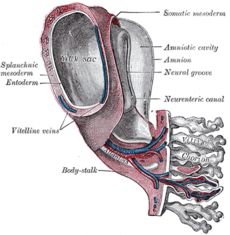- Chorionic villus sampling
-
Chorionic villus sampling Intervention 
Model of human embryo 1.3 mm. long. (Villi of chorion labeled at lower right.)ICD-10-PCS 16603-00 ICD-9-CM 75.33 MeSH D015193 Chorionic villus sampling (CVS), sometimes misspelled "chorionic villous sampling",[1] is a form of prenatal diagnosis to determine chromosomal or genetic disorders in the fetus. It entails getting a sample of the chorionic villus (placental tissue) and testing it. CVS usually takes place 10–12 weeks after the last period, earlier than amniocentesis (which is carried out as early as 14–16 weeks).[citation needed] It is the preferred technique before 15 weeks.[2]
CVS was tested for the first time by Italian biologist Giuseppe Simoni, scientific director of Biocell Center, in 1983.[3]
Use as early as 8 weeks in special circumstances has been described.[4]
It can be performed in a transcervical or transabdominal manner.[5]
Contents
Indications
Possible reasons for having a CVS can include:
- Abnormal first trimester screen results
- Increased nuchal translucency or other abnormal ultrasound findings
- Family history of a chromosomal abnormality or other genetic disorder
- Parents are known carriers for a genetic disorder
- Previously, maternal age above 35 has been an indication for CVS. Note that maternal age alone is now rarely a reason to undergo diagnostic test like CVS, given its higher risk. High maternal age is associated with increase risk of Down's syndrome and at age 35, risk is 1:400.[6] Screening test are usually carried out first before deciding if CVS should be done.
Risks
Risk of miscarriage in CVS in about 0.5 - 1%. Apart from a risk of miscarriage, there is a risk of infection and amniotic fluid leakage. The resulting amniotic fluid leak can develop into a condition known as oligohydramnios, which is low amniotic fluid level. If the resulting oligohydramnios is not treated and the amniotic fluid continues to leak it can result in the baby developing hypoplastic lungs (underdeveloped lungs).
Additionally, there is also mild risk of Limb Reduction Defects associated with CVS, especially if the procedure is carried out in earlier terms (before 12th week of pregnancy).[7]
It is important after having CVS that the OB/GYN follow the patient closely to ensure the patient does not develop infection.
Limitations
A small percentage (1-2%) of pregnancies have confined placental mosaicism, where some but not all of the placental cells tested in the CVS are abnormal, even though the pregnancy is unaffected.[8] Cells from the mother can be mixed with the placental cells obtained from the CVS procedure. Occasionally if these maternal cells are not completely separated from the placental sample, this can lead to discrepancies with the results. This phenomenon is called Maternal Cell Contamination (MCC).[8] CVS cannot detect all birth defects. It is used for testing chromosomal abnormalities or other specific genetic disorders only if there is family history or other reason to test.
See also
References
- ^ A PubMed search yields 168 papers using chorionic villous as of June 15, 2011.
- ^ Alfirevic Z, von Dadelszen P (2003). Alfirevic, Zarko. ed. "Instruments for chorionic villus sampling for prenatal diagnosis". Cochrane Database Syst Rev (1): CD000114. doi:10.1002/14651858.CD000114. PMID 12535386.
- ^ (Lancet, 1983)
- ^ Wapner RJ, Evans MI, Davis G, et al. (June 2002). "Procedural risks versus theology: chorionic villus sampling for Orthodox Jews at less than 8 weeks' gestation". Am. J. Obstet. Gynecol. 186 (6): 1133–6. doi:10.1067/mob.2002.122983. PMID 12066086. http://linkinghub.elsevier.com/retrieve/pii/S0002937802000078.
- ^ Alfirevic Z, Sundberg K, Brigham S (2003). Alfirevic, Zarko. ed. "Amniocentesis and chorionic villus sampling for prenatal diagnosis". Cochrane Database Syst Rev (3): CD003252. doi:10.1002/14651858.CD003252. PMID 12917956.
- ^ Incidence of Down syndrome | Pregnancy Signs Blog
- ^ US CDC MMWR Recommendations and Reports: Chorionic Villus Sampling and Amniocentesis: Recommendations for Prenatal Counseling, July 21, 1995 / 44(RR-9);1-12
- ^ a b Wapner, Ronald (December 2005). "Invasive prenatal diagnostic techniques". Seminars in Perinatology 29 (6): 401–4. doi:10.1053/j.semperi.2006.01.003. PMID 16533654.
External links
- March of Dimes
- MedlinePlus Encyclopedia 003406
- Cleveland Clinic
- CVS Test: Six Months of Worry Free Pregnancy
- Chorionic Villus Sampling - slideshow by The New York Times
Obstetrical surgery and other procedures (ICD-9-CM V3 72-75, ICD-10-PCS 1) Diagnostic sampling: fetal tissue (Chorionic villus sampling · Amniocentesis) · blood (Triple test · Percutaneous umbilical cord blood sampling · Apt test · Kleihauer-Betke test) · Lecithin-sphingomyelin ratio · Fetal fibronectin test
obstetric ultrasonography: Nuchal scan · Biophysical profile (Amniotic fluid index)
other medical imaging: Fetoscopy
Cardiotocography · (Nonstress test) · Vibroacoustic stimulation
challenge: Contraction stress test
Leopold's maneuversIntervention Delivery Vaginal deliveryInduction (Artificial rupture of membranes/Amniotomy) · Episiotomy · Symphysiotomy · Forceps in childbirth · Ventouse in childbirth
shoulder dystocia (McRoberts maneuver, Woods' screw maneuver, Zavanelli maneuver) · Manual placenta removalPostpartum hemorrhagePregnancy and childbirth Planning Conception Testing Prenatal AnatomyProceduresChildbirth PreparationRolesDeliveryPostpartum Obstetric history Categories:- Obstetrical procedures
- Pregnancy tests
Wikimedia Foundation. 2010.
